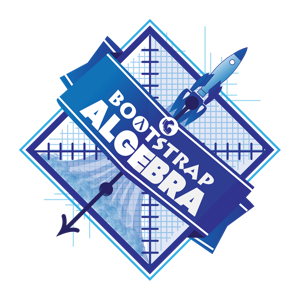Spanish
English
add translation
Bootstrap:Algebra


Unit 1Students discuss the components of their favorite videogames, and discover that they can be reduced to a series of coordinates. They then explore coordinates in Cartesian space, and identify the coordinates for the characters in a game at various points in time. Once they are comfortable with coordinates, they brainstorm their own games and create sample coordinate lists for different points in time in their own game.
Unit 2Students are introduced to a set-mapping representation for functions, in which the function object exists as a means of translating points from a Domain into a Range. Coupled with their understanding of Circles of Evaluation, students generalize their understanding of functions to include other datatypes, including Strings and Images.
Unit 3Students are introduced to the Definitions area, and learn the syntax for defining values of various types. They are also introduced to the syntax of defining functions and creating examples.
Unit 4Students continue to practice the Design Recipe by applying it to simple problems.
Unit 5Students define functions that map attributes of their game from one frame to the next, allowing them to move their dangers, targets, and projectiles.
Unit 6Students discover Boolean types, and use them to create programs that test values, and then model scenarios using these programs.
Unit 7Students use piecewise functions to move their players in response to key-presses.
Unit 8Students derive, discuss, and prove the Pythagorean theorem, then use this theorem—
in conjunction with Booleans— to detect collisions in their games. Unit 9Students edit game details, practice talking about their code, and prepare for their Launch Party!
Supplemental LessonsFor teachers looking for additional exercises, we have compiled many activities for students to go deeper into the material. Have students use composition and coordinates to create flags for their countries of origin, or for a country they want to make up! Have them use randomness and trigonometric functions for more sophisticated motion, or introduce data structures for more sophisticated games!
Student Workbook
You can purchase beautiful, bound copies of the workbook from Lulu.com, or print your own. The lesson plans are tightly integrated with the Student Workbook, which should be used with the curriculum. A Teacher’s Edition is also available upon request.Significant discounts on printed books are available to teachers who attend our professional development workshops. Contact us to find out more.
Teacher-Only Resources - We also offer several teachers-only materials, including an answer key to the student workbook, a quick-start guide to making the final project, and pre- and post-tests for teachers who are paticipating in our research study. For access to these materials, please fill out the password request form. We’ll get back to you soon with the necessary login information.
Support Forums [Announcements | Discussion] - Want to be kept up-to-date about Bootstrap events, workshops, and curricular changes? Want to ask a question or pose a lesson idea for other Bootstrap teachers? These forums are the place to do it.

